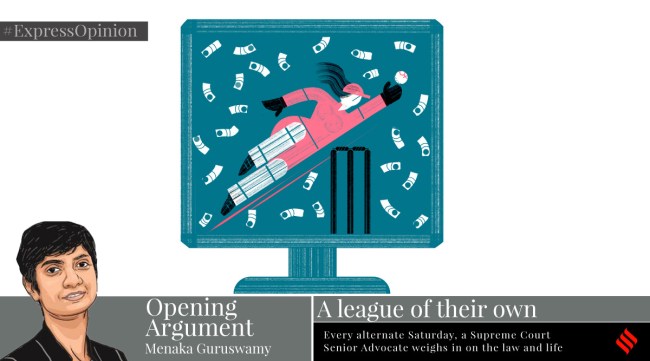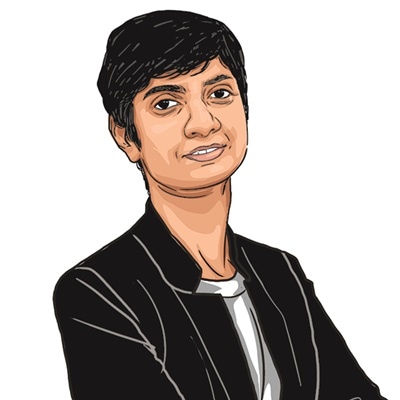Opinion Menaka Guruswamy writes: Women’s Premier League marks a new beginning
The Premier League will offer opportunities for women's cricket in India. It must be celebrated and supported.
 In the absence of an IPL-like league till recently, despite the enhanced support it’s been receiving, the wealth for players that a private league generates was missing. As was missing the vast television audiences and rights revenues that private leagues generate. (Photo: C R Sasikumar)
In the absence of an IPL-like league till recently, despite the enhanced support it’s been receiving, the wealth for players that a private league generates was missing. As was missing the vast television audiences and rights revenues that private leagues generate. (Photo: C R Sasikumar) The tagline was a familiar one, “26-year-old Indian cricketer signed by the Royal Challengers, Bangalore for 3.4 crore in player auction”. However, it was anything but familiar — for the cricketer in question was India’s star opening batter and vice-captain Smriti Mandhana. Mandhana was bought by the Royal Challengers, Bangalore for the inaugural season of the Women’s Premier League (WPL).
India’s captain Harmanpreet Kaur was bought by the Mumbai Indians for Rs 1.8 crore, while all-rounder Deepti Sharma was secured by the UP Warriorz for Rs 2.6 crore. 19-year-old Shafali Verma was signed by Delhi Capitals for Rs 2 crore.
From March 4 to 24, six days after the Women’s T 20 World Cup ends in South Africa, cricket will embark on its historic first WPL season.
Administered by the Board of Control for Cricket (BCCI), the WPL is valued at US$572 million and will comprise five teams in the inaugural version. These five teams will be one each from Delhi, Mumbai, Bengaluru, Ahmedabad and Lucknow. Three of the owners also own teams in the men’s India Premier League. These are Reliance Industries which owns the Mumbai Indians, Diageo owns the Royal Challengers Bangalore and JSW GMR which owns the Delhi franchise of the IPL.
The WPL will comprise 22 games. The team that finishes top of the league will directly head to the finals with the second and third-placed teams, playing each other for a place in the finals. Lest one only dismisses this as WPL still having a way to go — investors have confidently bid a combined $572 million for it, with Reliance Industries acquiring global television and digital rights for $117 million.
This is a historic time for women’s cricket. It finally is moving away from decades of poor funding and indifference, which also included a time when top cricketers would be asked “who is your favourite male cricketer?” at a post-game conference after a tightly-fought match. To put it mildly, while men’s cricket is remarkably well-supported, women’s cricket has been its poorly supported and much-neglected sibling. The likes of Jhulan Goswami and Mitali Raj, who were amongst the finest exponents of the game and have retired, did not have the benefit of a WPL, and we didn’t have the privilege of seeing them play enough cricket games.
In the absence of an IPL-like league till recently, despite the enhanced support it’s been receiving, the wealth for players that a private league generates was missing. As was missing the vast television audiences and rights revenues that private leagues generate. The WPL will provide opportunities for younger uncapped players to play on the big stage, and television rights will ensure that women’s cricket is beamed into more households than before. This will mean that more girls will know that they too can play the game and be the next Smriti Mandhana or Harmanpreet Kaur.
For now, there is much excitement in women’s cricket. A few days ago, I called my mother, who appeared to be in a hurry to get off the phone. My 74-year-old mother, an avid sports buff said, “yes yes, we are fine. We are waiting for the India-Pakistan cricket match to start.” She asked me, “aren’t you watching it?!” It didn’t seem the right time to bring up a lawyer’s conference schedule for cases the next day. But, I did switch on the game to check in.
The cricket match in question was the T20 World Cup 2023, being played in South Africa. The opening match was between India and Pakistan, played in picturesque Cape Town on Sunday, February 12. While India won comfortably reaching the target of 150 runs losing only three wickets, Pakistan’s total was made possible by their captain Bismah Maroof who hit 68 runs off 55 balls. For India, Jamimah Rodrigues top scored with 53 runs of 38 balls. By the way, on February 15, India beat West Indies by six wickets. So, our team is looking good!
Unsurprisingly, India is playing well in the T20 World Cup. Our team has a formidable record of reaching the final of the 50-over World Cup in 2017, and the World T20 final in 2020. This despite the lack of big match experience due to the low number of games India’s women cricketers play. The WPL will help address this deficiency, and like the women’s leagues in Australia and England contribute to both development of the game and fine-tuning of the national team.
Now I can wax eloquent about how much the WPL matters or as a cricket enthusiast you can just sit back and watch the women’s T20 World Cup as a prelude to the league. If you tune in you can appreciate Shefali Verma playing an elegant square cut, or Smriti Mandhana showcasing a cracker of a cover drive. Or you can watch the allrounder, Deepti Sharma, a crafty leg spinner getting the opposing batter leg before wicket. You can see all of this and more as the Women’s T20 World Cup progresses. Games can be viewed online as well as on television. It’s cricket season, folks! Finally, our women cricketers have a league of their own!
The writer is a Senior Advocate at the Supreme Court






